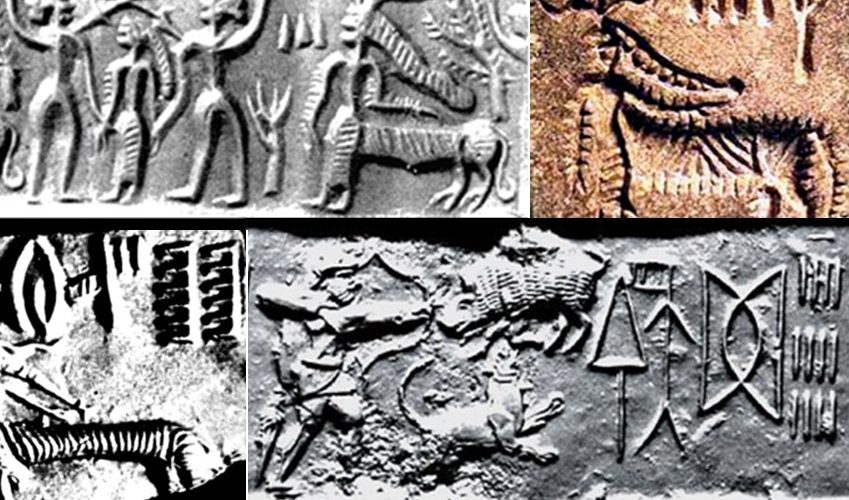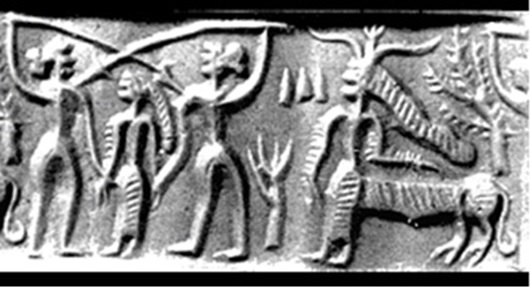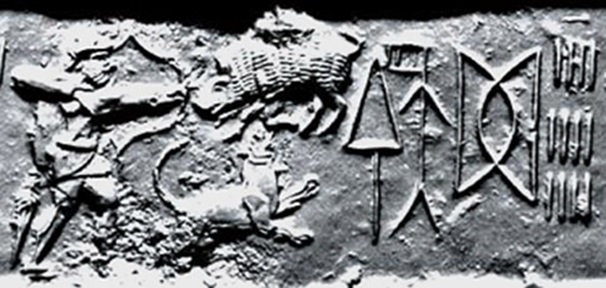The Geographical Migration of Vratyas:
The Atharvaveda 15.2 makes a very ambiguous statement: “Of him in the eastern quarter, faith is the harlot, Mitra the Magadha, discrimination is the garment, etc”. Probably, it is taken to mean that the Magadha tribes (The area of present day Bihar, South of Ganges) were friends, advisers, and thunder (strong Supporters) of the Vratyas. The implication of this is rather interesting. The breakaway group, the Vratyas from among the Vedic people, left their main land of the basin of Indus river and moved away eastwards.
Vratyas are also described to be pre Vedic people, but associated more with nature and declined the formalism of Vedic seers. They were not accepted by Vedic followers; hence, Vratyas moved away from them. They roamed over to the East; and ultimately settled in the regions of Magadha and Anga where they found friends and supporters. (Magadha and Anga is mostly, in the regions to the East and North-west of the Madhyadesha – the mid part of Ganga Valley, the present day Uttar Pradesh). The reason for that friendly reception appears to be that the Magadha tribes in Eastern India were not in good terms with the Vedic people in the Indus basin; and saw no difficulty in accommodating the Vratyas. In addition, more importantly, the Magadha did not follow or approve the Vedic religion; and they, too, like the Vratyas, Were against the rites, rituals, and sacrifices of the evolved Vedic community.
Depiction of Vratyas and Vratya Stoma, A Ritual of Proselytization (attempt to convert) in the Harappan Seal of Kalibangan:
Interpreting Indus seals by deploying the literary sources, social and cultural practices that prevailed in those times brings out the information hidden in the seals. The seal, analysed here, show a strong correlation to Social practices that were followed in Vedic period.
The Seal of Kalibangan (Fig. 3), with four male figures, show three types of dress Code of men. The last and fourth figure is a peculiar picture of a man merging with a tiger. The human part has feet as human legs but the other two back legs are like that of goat and a tail of tiger. This seal is the Symbolic representation that vratyas were forceful fighters, skilled hunters, lonely and fearless like tiger or some lived in groups like goats. This idea is also conveyed through both man and animal forms with the same animal skin.
The man is adorned with the animal skin, serrated arms (Vajra bahu) and has long matted hair. Their head is decorated with twigs or flowers, long matted hair is depicted horizontally like a Snake and a long turban that adorns his head is well displayed. Of the first three figures, the middle one is a vratya without the head decorations or matted hair but still with the turban. He is wearing animal skin but feet are like human. The two taller figures on either side hold the point of the long lance to the shoulder region. They have hair tied into a bun, wearing woven cloth and not wearing animal skin (may be the evolved dwija status) Vratyas were an unorthodox group who detested the practices of Worship of Indra that was followed by the orthodox evolved class of people called Aryans and hence were not included in the Aryan group.
Katyayana Shrauta Sutra (22.4, 1-28) also says that by performing vratya Stoma, Vratyas lose their vratya Status and become eligible for social life with the followers of dharma. Vratya stoma is the rite of adoption of a group of four Ekaha (Soma Sacrifice of one day duration) adopted by Vratyas so that they can renounce Vratyahood and then become socially eligible and accepted as orthodox Brahmin class- dvija. It is a remarkable rite and the only proselytization (attempt to convert) in Vedic rituals. Vratyas were considered divine by some Scholars as they belonged to Sage Vata Rashana and were called followers who moved swiftly like Vayu – the wind. The Seal (Fig.3) depicts two figures holding a long lance, the Weapon of Vratyas-the Shula that is pointing to the shoulder where Yajnopavita is worn and the Vratya man is standing in between them. The fourth figure shows a combination of man and animal depicted as though they are one, which depicts the Vratya in original form.
This seal is informative about how Vratyas had an option to convert themselves to the Dvija – orthodox Brahmin class by performance of four Agnistoma Ekaha as an expiatory ritual, after which they wore the Yajnopavita, the sacred thread on their left shoulder. They also changed their dress Code from animal skin to clothes that Orthodox class Wore. The person who intended a conversion had to come with animal skin in black and white colours and a pair of shoes shaped like ears and other accessories they often sported. All these articles were donated to another Vratya (the fourth human figure) who had not undergone conversion or donated to a Brahmin of Magadha region, a place that was not strictly Brahmanical. After the ritual, the aspirant Vratya ceased to have the characteristic objects, changed their dress code to woven cloth, tied their hair, and gained full membership to Brahmanical Society in pursuit of learning the evolved form of the sacred language. (Vratyas, though spoke Sanskrit did not use the refined Vedic dialect). The fact that Vratyas attempted for their conversion to the Dvija – Brahmanical, has been depicted in the seal through the depiction of two types of costume representation – the orthodox and Vratya style of dress code and hair do.
Depiction of Rudra-the Vratyapati, Shooting the Arrow at Tripurasura:
The Vratyas worshipped elements of nature and Rudra was their preferred deity. The figure of Rudra shooting with his special type of String-less bow Jyadroda, depicts an episode of the fight between Devas and demons. The seal looking like a frozen action tableau, with man and animals in action is associated with the episode of the conflict between the Devas and the demon Tripurasura, as described in Yajur Veda. Yajurveda (The Veda of The Black Yajus School, A. B. Keith), Kanda 4.5.3 Says about Rudra, his bow and arrows:
“Homage to the turbaned wanderer on the mountains to the lord of pluckers, homage to the bearer of arrows, and to you the bow man, homage to that string(the bow), homage to you that bend (the bow), and to you that let go the arrows, homage’.
The seal depicting an episode is a good example of arthavada type of explanation as prescribed in Brahmana texts (Fig. 4). The first half of the seal has one human figure, shooting arrow at a wild boar and a dog is also chasing the animal. Some Symbols are inscribed on the other half of the Seal to convey some information about the episode depicted. Since the hunter wears a turban, holds a strong bow, it can be linked to the epithet of Rudra as Tripurantaka, that is described in Yajurveda.
Of the several epithets of Rudra in Shatha Rudriya of Yajurveda celebrates the glory of one-hundred-and-eight forms of Rudra. Some are relevant to the picture of Rudra in the seal Fig. 4. He is called Vratya pati-the leader of vratyas, Pinaki-the holder of the mighty bow Pinaka which is also called Jyadroda, Usnishi – the turbaned wanderer, Tripurantaka-killer of tripurasura demon, Swapatibhyascha -keeper of hounds/dog, and So on.
Looking like a Warrior in a heroic posture he is shooting an arrow at an animal the wild boar, which is a representation of demon Tripurasura. Regarding the story part, (The Veda of The Black Yajus School, AB Keith) Kanda-6, Prapatika 2 and 3 says:
“The Gods and Asuras were in conflict. The Gods in fear entered Agni- (meaning seek protection). Therefore, they say Agni is all the Gods. Asuras had three citadels, the lowest was of iron, and the middle of silver and the topmost was of gold. The Gods could not conquer the 3 citadels; hence, sought to conquer them by siege. They made ready an arrow with Agni as the point, Soma as the socket (Bow) and Visnu as the shaft of the bow. They said: Who should shoot the arrow? “Rudra’, they said, as Rudra is Cruel, let him shoot it. Rudra Said “let me choose a boon. Let me be the overlord of cattle.”
Therefore, Rudra became the overlord of animals. “Rudra let it go’, it cleft the three citadels and drove the Asuras away from the three Worlds.
The details of the episode is that the demons when they turned out stronger, occupied all the three worlds and built citadels of iron, silver and gold. Gods decide to wage a war against them and chose Rudra because only he was the owner of the bow and physically strong enough to shoot arrows that would cross the three Worlds. The arrows used by Rudra for his Pinaka bow was unique. Agni Settles as the head of the arrow as he could move in upward direction. Vishnu (also called rays of Sun) settled in the shaft as he had the capacity to cover all three worlds. Goddess Saraswati settled at the tip of the arrow as Mantras or knowledge. The demon Tripurasura gets defeated when a powerful arrow was shot and runs out of the citadel. Rudra was hence called Tripurantaka-the destroyer of demon.
The Symbols:
Regarding the Symbols, they indicate the deity involved, period of the episode and the yajna to be performed as per the “Vidhi’ ways of explaining a ritual.
Symbol.1. The Arrow
Agnishikha is a fearsome fire arrow (like a rocket). According to the legend of Yajurveda 6.2.3, the Gods and Asuras (demons) were in conflict. The Gods in fear entered Agni. The arrow, designed by Devatas, has Agni in the triangular part (the Symbol of eternally moving upwards), and Sarasvati – the goddess of Mantra being installed at the tip of the arrow and Vishnu in the shaft to cover space. The upward triangle is the Symbol of Agni, the eternally upward moving element, and fire is revered as Agni. Agni and Brihaspati, indicative of the heat and light aspects of fire are Symbolised by arrow and read according to the theme presented in a Seal.
Symbol.2. The Citadel of Gold (called Brahmapuri)
The Symbol has the representation of the citadel that looks like the Structure of a house above the arrow. Asuras had three citadels, the lowest was of iron, and the middle of silver and the topmost was of gold (called Brahmapuri). The Gods could not conquer the three citadels; hence, they sought to conquer them by siege. Rudra shot the arrow from his mighty bow Pinaka, drove the Asuras away from the three Worlds and recovered the citadels. The demon called Tripurasura is represented as wild boar, running away. The arrow is depicted as crossing the two Worlds and the citadel can be seen like a house in the top part of the arrow.
Symbol 3. The Solstice day
The third Symbol that is inscribed has three sections. A circle indicative of the period of one year is cut here into two halves. The first arc is the first six-month of the year, and similarly the second arc Vratyas in Indus Seals 113 represents the other half of the year. The middle part is the Visuvat day. The Symbol of two half circles, crossing at the middle part and creating a space may be the indication the Visuvat, the autumn Solstice where the day part is shortest. The halves of the year, (two arcs in opposite direction) are his right and left halves. The two solstice’s days are indicated as two lines adjoining the side of the arcs.
Visuvat is the central auspicious day that divides the Gavamayana Sattra, the Sacrificial Session lasting one year into two equal parts. The two-intersecting bow / curve indicate the travelling of the Sunrays between the Dakshinayana and the Uttarayana path of Sun’s rays. The central day of the solstice is the auspicious Vishuvat day on which the Gods won wealth from the daemons, and hence, celebrated by chanting of Samans of Ekavimshatistoma on this day (AP. SR 21.15-16, as quoted by Sen).
Symbol 4. The 12 Day Sacrificial Ritual
The last Symbol of twelve strokes also indicates the celebration of victory of Devas by the performance of “sattra”-the eleven or twelve-day sacrificial session, a type of. When it extends to one year, it is called Gavamayana satra or SamvatSarika.
The 12 day sacrifice called Dvadasha ratra is performed for long life. By performing the eleven and twelve day sacrifices, one can create, win, procure, and possess offspring. This may indicate that one must not only procure offspring, but also should be able to live harmoniously with them.
Conclusion:
One of the significant type of Seals under Vratyas, describing the Social aspects of this group of ascetics, are very well depicted in the four seals that are described in this text. The highlight of this research is an extraordinary correlation to the social and ritual practices that were followed in those times. In a way, these seals depict the life and practices of Vratyas to the Vedic practices in a precise manner.
The fact that Vratyas who were followers of Rudra did not accept Indra as their deity, might have been the cause for clashes with the evolved Aryans forcing vratyas to migrate to the Gangetic plains where they got accepted.
This paper is an independent research on Vratyas may prove as the first step in the new approach of understanding what these set of seals Communicate.
Reference:
- Bloomfield, Maurice (translator):1897b, Hymns of the Atharvaveda, http://www.sacred-texts.com/hin/sbe42/
- Eggeling, Julius (translator):1894,The Satapatha – Brahmana – According to the text of the Madhyandina School, Clarendon Press, Oxford
- Gangeswarananda, Swami: 1959,The Satapatha Brahmana, Volume 2 Vijnanabhasya, Atlantic Publishers and Distri.
- Griffith, Ralph T. H.: 1973 (revised) (reprint 2004),The Hymns of the Rigveda, Motilal Banarsidass Publishers Private Limited, New Delhi
- Keith, A. B.: 2007, The Religion and Philosophy of the Veda and Upanishads, Motilal Banarasidass, New Delhi
- Keith, Arthur Berriedale (translator), : 1914 (accessed in 2014), The Veda of the Black Yajus School (Taittiriya Sanhita), http://sacredtexts.com/hin/Yajurveda/index.htm,
- Macdonell, Arthur A.: 1899, A History of Sanskrit Literature, Munshiram Manoharlal, New Delhi
- Radhakrishnan,S.: 1989, Indian Philosophy, Volume 1, Oxford University Press, New Delhi
- Rao, Rekha :Symbolography in Indus Seals by via Amazon at: http://amzn.com/B016OOKBOE Vratyas in Indus Seals 115
- Sen, Chitrabhanu: 1978 (reprint 2001), A Dictionary of the Vedic Rituals, Concept Publishing Company, New Delhi
- Cultural Heritage of India – Volume 1-5, Published by Swami Prabhananda, Secretary, The Ramakrishna Mission Institute of Culture, Calcutta, 2000
- Shatarudriya,www.swami-krishnananda.org/invoC/in_Sata.html
The article first appeared in Arnava Vol VI No 1 (2017) and has been republished with permission.
Disclaimer: The facts and opinions expressed within this article are the personal opinions of the author. IndiaFacts does not assume any responsibility or liability for the accuracy, completeness,suitability,or validity of any information in this article.
Independent Researcher and Indologist, Mysore



